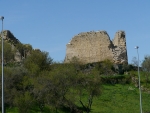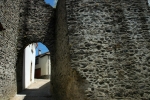DirectoryENG
- BRIDGES AND SIDEWALKS (5)
- CASTLE (6)
- CRUISE
- EMBLAZONED HOUSE (8)
- FOUMTAIN (2)
- HISTORIC BUILDING (6)
- MANOR HOUSE (1)
- PILLORY (14)
- RUINS
- SQUARE (1)
- TRACE RUPESTRES (2)
Description: Located in the TuelaRiver, on the road that connects Vinhais to Nunes. It is believed that of the medieval era.
Date: Pre-historic
Description: In Picot a berrão (proto-historic statues of stone, carved in full relief with zoomorphic figures) was found in 1952 in an area where archeological findings of an ancient sanctuary linked to fertility rituals until the 4th century. This zoomorphic sculpture is placed in the Church´s plaza.
State of Conservation: Good
Description: Chapel in ruins which the only remains are the walls and the main chapel. Nearby the visitors can find the two places excavated in the rock.
Date: House of the 17th century
Description: Manor House of the Pimentel Family is a baroque mansion on two floors, with the main facade to the street named Rua Direita, which bears on the main floor the coat of arms of the families Morais and Pimentel, from the 19th century.
State of conservation: in the restoration.
Source: Património dos Concelhos da Terra Fria Concelho de Bragança VOLUME I
Date: 15th century.
Valuation: National Monument
Description: This defensive system consists of the walls, the Castle, which includes the Torre de Menagem, the PrincessTower, and the Fountain of the King. The wall has a circumference of 600 meters, has 15 towers, is interrupted by the door of the Vila or door of Santo Antonio, and opposite the Porta do Sol (door of the sun) and the Porta da Traição (door of betrayal).
State of conservation: Very good
Source: Património dos Concelhos da Terra Fria Concelho de Bragança VOLUME I
Dating: medieval castle from the 14th/15th century. First referenced in the year 1172.
Description: this well constructed castle was used to resist the successive Castilian attacks, in the reign of D. Fernando. During the War of the Restoration the castle was severely damaged and in the year 1644 King João IV, ordered to rebuild the walls, adapting it for artillery, but still it resisted with difficulty to the Spanish attacks. In 1762, during the War of the Seven Years, the castle was surrounded by the Spanish army who decimating great part of the garrison and ruining the castle.
This fortification was classified as of public interest. Part of the wall raised in 17th century still remains, surrounding the old nucleus of the city and the Main Tower. Nearby is the cathedral of Miranda.
Classification: Listed as property of public interest (Dec. nº. 40361 of 20-10-1955).
State of Conservation: Reasonable
Description: It is not known when built or what monarch was responsible for its location but some authors argue that it was the King D. Dinis. Because of its border location, the castle had great military significance, because the territory has always been desirable by neighbouring monarchs.
Evaluation: Valued as property in the public interest, Dec. N ° 36383 DG 147, 28 June 1947.
Date: Middle Age / modern age.
Description: easel Board Bridge of three arches that rest on uneven with long ramps. The Arc is the largest of the Middle arch, broken bow South side, North side of the arc is perfect turn. The Board is about 3 meters wide; it is paved with bituminous coating and has metal protection. The device is in Shale Brick.
State of conservation: good.
Source: Património dos Concelhos da Terra Fria Concelho de Bragança VOLUME I
Date: 13th/ 16th / 18th centuries.
Valuation: National Monument (Desde 16.06.1910).
Description: The Benedictine monastery of Castro de Avelãs enjoyed the protection of Afonso Henriques, exerting a decisive influence on the economy of this region in which it is implanted, at least until the 13th century. It was a very important monastic Centre in the northeast between the 12th and 16th centuries. The Church is situated between the ruins of the convent and the remains of a tower and friary. The old church was built and incomplete Romanesque mudejar Root Lion, with red brick, a material seldom used among us. This project was never completed, with three semicircular chapels, one of the towers of the facade and the beginning of the wall of the Hall, visible on the South side. In southern apsidal is a monolithic, composed of wild arc granite. The tomb is decorated with two coats of arms and a registration without end – “ERA DE MIL E CCC “- engraved on the cover.
State of conservation: good.
Location: Village of Castro de Avelãs
Legends and traditions: an old tradition says that the Tomb, stored inside one of the apses, belongs to D. Knight Pelayo, known as Earl of Ariães. According to the legend, this Earl led a victorious war against the incursions of the Muslims in D. Ramiro II, who loved the inhabitants of Bragança. The king proposed him to deliver the city if he was agreed to enter in a challenge with a Moor, but in unequal strength. Confident in his victory, the Earl accepted the challenge on the day of St. George, who pledged, in case of victory, to erect a chapel in his invocation that annually visit in procession. He defeated the enemy, at the edge of Ariães, and had built a temple in honour of St. George.
Source: Património dos Concelhos da Terra Fria Concelho de Bragança VOLUME I
Date: Early Iron Age (12th century B.C.)
Description: Castro (name given to a Roman or pre-roman castle) of the villages of Aldeia Nova and S. João das Arribas is one of the first examples of the Iron Age, later Romanized, probably kept till the Middle Age. To the east is the River Douro.
Classification: National Monument. Decreto de 16-06-1910, DG n.º 136, de 23-06-1910










